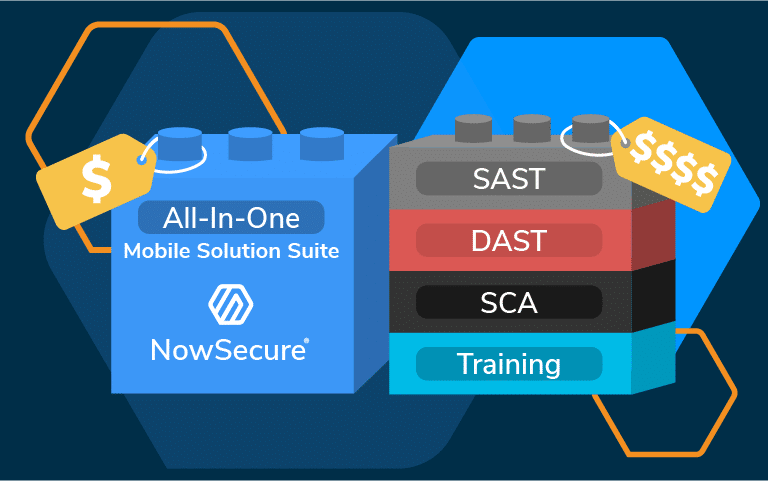While the world runs on mobile apps, the importance of a robust mobile app security testing (MAST) stack cannot be overstated. As attackers have turned their eye to mobile apps such as Chick-fil-A, RingGo, Shein and UnitedHealthcare, dev and security teams must deploy a modern, multi-layered approach to safeguard their mobile applications.
Modern Mobile App Security Testing (MAST) Stack
Security represents a critical component of application testing and quality assurance. Just as organizations perform functional, integration and performance testing in the software development lifecycle, they must thoroughly assess mobile app security and privacy vulnerabilities and fix them prior to release. Like the typical web app security testing stack, the common mobile app security testing stack includes four key tools: SAST, DAST, SCA and mobile security training. (Learn more about web and mobile security similarities and differences.)
- Static Application Security Testing (SAST): SAST analyzes code statically (either source code or compiled binary code) to identify potential security vulnerabilities, like misuse of APIs, hardcoded credentials or improper error handling. It helps detect and fix security flaws early in the dev process, reducing later remediation costs. SAST has the benefit of being able to run early in the dev process but often generates high false positives.
- Dynamic Application Security Testing (DAST): DAST tests run mobile apps from the outside to surface vulnerabilities such as authentication issues and data leakage. It’s crucial for identifying security weaknesses that are not apparent in static code analysis. DAST has the benefit of fuller coverage of running code, but requires an automation engine to drive the mobile app.
- Software Composition Analysis (SCA): SCA examines an app’s open-source components to identify known vulnerabilities and outdated libraries. This method ensures the security of open-source elements integrated into the mobile app, preventing common issues such as insecure LocalAuthentication configuration, outdated libpng libraries or known vulnerable versions of dependent SSL libraries.
- Mobile Security Training: Training upskills developers and security teams on secure coding techniques and educates them about how to avoid or identify common coding mistakes. Proactive security training helps ensure higher quality as the code is written. In addition, just-in-time security training included with issue tickets helps dev learn how to fix the issue quickly and prevent them from making the same mistake again.
A comprehensive technology approach not only detects and mitigates potential vulnerabilities at every stage of the SDLC, but also protects the mobile app against emerging threats. The modern mobile app security testing stack is not simply a technical necessity, but acts as a fundamental digital transformation aspect of building user trust, safeguarding the business and maintaining the integrity and resilience of mobile apps in our global economy.
A comprehensive technology approach not only detects and mitigates potential vulnerabilities at every stage of the SDLC, but also protects the mobile app against emerging threats.
Old World vs. New World Approach
In the traditional landscape of desktop and web application security and now even mobile application security, leaders often took a patchwork approach to solution adoption by combining free open-source tools with commercial tools acquired incrementally. While initially cost effective, this strategy usually resulted in a complex mesh of technologies that each required deployment, training and integration.
Security managers have long grappled with the challenges piecemeal adoption presents, such as compatibility issues, inconsistent data formats and straddling the delicate balance between overlapping functionalities and unaddressed security gaps. As the toolset expands, so do the expenses and intricacies, particularly when addressing problems like data synchronization failures or the burden of system updates and maintenance.
Although individual solutions may demonstrate ROI sooner, the total cost of ownership (TCO) of a patchwork approach often rises more quickly. In some cases, certain tools prove incompatible with established workflows, leading to underutilization or outright abandonment by frustrated teams. This fragmented security tooling strategy not only taxes budgets but also threatens the overall efficacy of application security and the performance of security teams.
The new world today increasingly adopts comprehensive, all-in-one solutions like NowSecure Platform. NowSecure Platform provides a full MAST stack of automated SAST, DAST, SCA and training in a single cohesive system, designed to all work together and fully integrate into your mobile app development workflows. Plus NowSecure Platform offers options for manual pen testing tools, pen testing services, guided testing and independent security validations like ADA MASA. NowSecure Platform also includes standards- based test coverage for OWASP MASVS, ADA MASA and mappings for key regulatory compliance mandates like CCPA, GDPR and HIPAA.
The NowSecure Platform all-in-one application testing approach balances functionality and convenience, offering the best mix of mobile app security and privacy testing capabilities fully integrated into a great user experience. This shift is not solely about simplicity. It represents a fundamental change in how security and development teams think about and manage their mobile app security testing technology stack while prioritizing ease of use and efficiency.
7 Reasons Why All-in-One MAST Beats Piecemeal Solutions
- Cost Effectiveness: An all-in-one solution is less expensive, from initial purchase to implementation to long-term maintenance costs.
- Faster Implementation & Deployment: Implementing one solution typically provides a faster, easier rollout, enabling teams to operate faster and with fewer deployment hurdles.
- Consistent User Experience: A single product ensures a uniform user interface and experience across all its features, reducing the learning curve and boosting efficiency compared to using a mix of different tools with varied interfaces.
- Simplified Integration & Compatibility: An all-in-one solution is designed to have its components work seamlessly together, eliminating the compatibility issues that can arise when integrating multiple tools from different vendors.
- Reduced Complexity: Managing one integrated system is simpler than maintaining multiple products. This simplification extends to patches and updates due to a unified update schedule.
- Easier Training & Support: Training teams on one integrated system is easier and less time consuming than training them on several tools. Additionally, having a single vendor to contact for assistance streamlines support and troubleshooting.
- Consolidated Data & Reporting: An all-in-one system offers unified data analysis and reporting tools, providing a holistic view of mobile app security data across all testing types. That can be more difficult to achieve with disparate systems.
Increase Coverage and Cost Savings
Eager to explore how to boost coverage and efficiency? The NowSecure Business Value Calculator resource helps you understand and address gaps and inefficiencies in mobile app security testing programs. Model your current mobile AppSec tech stack to identify areas for improvement to cost effectively scale mobile AppSec programs while simultaneously strengthening your mobile app security posture to reduce risk.
Consolidation is here for cost savings and efficiency. The evolution from a fragmented collection of individual application security tools to a unified, all-in-one platform marks a significant shift in MAST. This change simplifies testing stack purchase, deployment, operations and management while reducing risk. By embracing NowSecure Platform, organizations can benefit from full-coverage testing and consistency, all of which strengthen mobile app security at lower cost.





